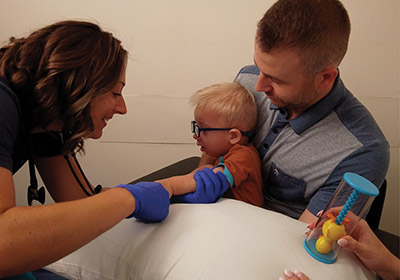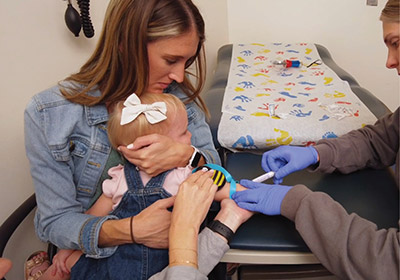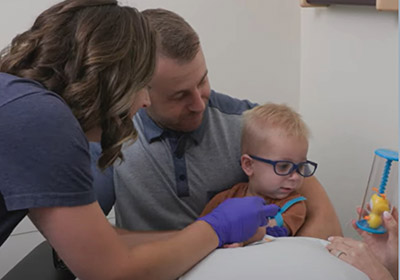Comfort Positions for Lab Draws for Infants and Toddlers, Ages 12-24 Months
Reviewed by Child Life
As hard as you try, it can be difficult to reassure a child that the doctor's office isn't something to be afraid of. At Boys Town National Research Hospital and Medical Clinics, we want to help provide an emotionally safe experience for your child and for you. Whether it's a simple examination, a blood draw or another procedure, these comfort positions can help calm and reassure children and teens.
Comfort Positions for Infants and Toddlers (Ages 12 to 24 Months)
Little ones are often easier to contain during moments of tension or stress. It's important to talk calmly to your child during the hold and procedure. Pacifiers have been studied and recommended for pain relief for infants having minor procedures like a blood draw. Many doctors' offices also have a sucrose (sugar) solution available to address additional pain relief for infants, so please feel free to ask.
Different comfort positions for infants and toddlers (ages 12-24 months) during a lab draw include:
- Back-to-Chest
- Place your child in your lap facing forward
- Wrap your arms around your child and hold their hands and arms with yours and try to keep their back and bottom pressed firmly next to you
- Allow the arm they will use for the lab draw to come out from under your arm and make sure you hold on to it so your child doesn't try to reach for the needle
- Use your legs to “scissor" your child's legs or a nurse or provider can lean against your child's legs to prevent kicking
- Hug your child firmly and sometimes it's even possible to hold a phone with a video for distraction

- Chest-to-Chest
- Place your child in your lap facing you and straddle their legs around your hips
- Ensure your child cannot use their legs to push away from you
- Hug your child firmly with their free arm tucked into their chest and their other arm out for the lab draw

- Side-sit on Lap
- Place your child on your lap with one arm leaning into your body and their other arm out for the lab draw
- Use your legs to “scissor" your child's legs or a nurse or provider can lean against your child's legs to prevent kicking
- Hold your child firmly and, if possible, hold a phone with a video for distraction

If you are an outside organization that is interested in learning more about our CARES Emotional Safety Program, please
fill out this form.
